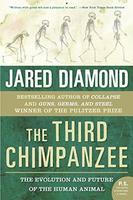The Third Chimpanzee
The Third Chimpanzee: The Evolution and Future of the Human Animal is a 1991 book by academic and popular science author Jared Diamond, in which the author explores concepts relating to the animal origins of human behavior. The book follows a series of articles published by Diamond, a physiologist, examining the evidence and its interpretation in earlier treatments of the related species, including cultural characteristics or features often regarded as particularly unique to humans. The book was released in the United Kingdom in 1991 by Radius under the title The Rise and Fall of the Third Chimpanzee: How Our Animal Heritage Affects the Way We Live and in the United States in 1992 by HarperCollins under the title The Third Chimpanzee: The Evolution and Future of the Human Animal. In 2014, Diamond published an adapted version for young people with Seven Stories Press titled, The Third Chimpanzee for Young People.Diamond explores the question of how Homo sapiens came to dominate its closest relatives, such as chimpanzees, and why one group of humans (Eurasians) came to dominate others (indigenous peoples of the Americas, for example). In answering these questions, Diamond (a professor in the fields of physiology and geography) applies a variety of biological and anthropological arguments to reject traditional hegemonic views that the dominant peoples came from "superior" genetic stock and argues instead that those peoples who came to dominate others did so because of advantages found in their local environment which allowed them to develop larger populations, wider immunities to disease, and superior technologies for agriculture and warfare. The Third Chimpanzee also examines how asymmetry in male and female mating behaviour is resolved through differing social structures across cultures, and how first contact between unequal civilizations almost always results in genocide. The book ends by noting that technological progress may cause environmental degradation on a scale leading to extinction. Source: Wikipedia (en)
Editions
6- date of publication: 2006-01-03ISBN-13: 978-0-06-084550-6
- ISBN-13: 978-1-78074-605-0
- date of publication: 1993ISBN-13: 978-0-06-098403-8
In your inventory
In your friends' and groups' inventories
Nearby
Elsewhere
Work - wd:Q440914



